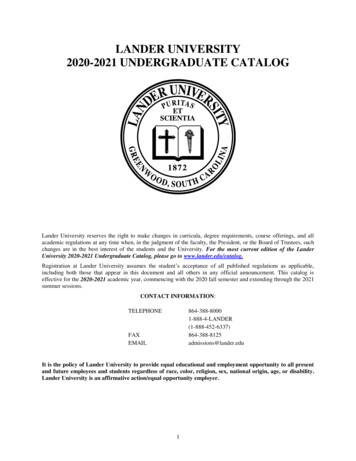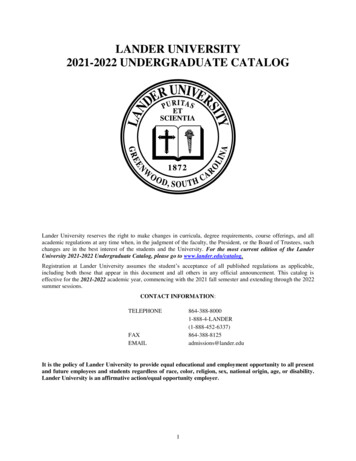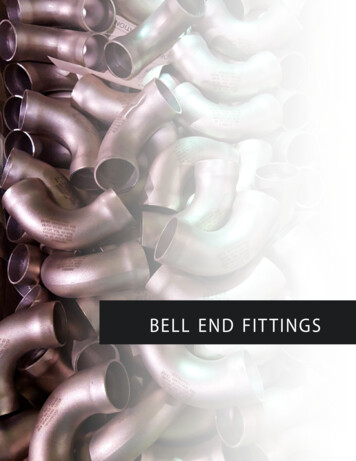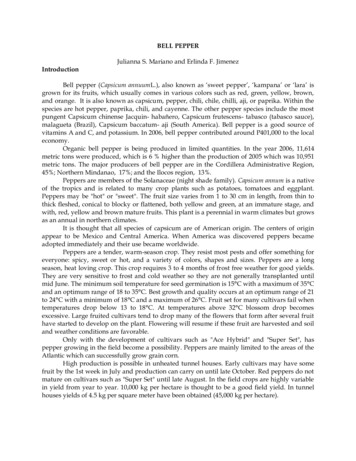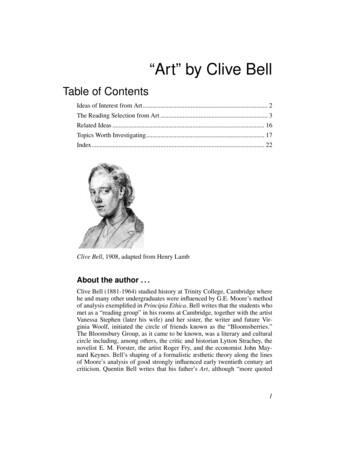
Transcription
“Art” by Clive BellTable of ContentsIdeas of Interest from Art. 2The Reading Selection from Art . 3Related Ideas . 16Topics Worth Investigating. 17Index. 22Clive Bell, 1908, adapted from Henry LambAbout the author . . .Clive Bell (1881-1964) studied history at Trinity College, Cambridge wherehe and many other undergraduates were influenced by G.E. Moore’s methodof analysis exemplified in Principia Ethica. Bell writes that the students whomet as a “reading group” in his rooms at Cambridge, together with the artistVanessa Stephen (later his wife) and her sister, the writer and future Virginia Woolf, initiated the circle of friends known as the “Bloomsberries.”The Bloomsbury Group, as it came to be known, was a literary and culturalcircle including, among others, the critic and historian Lytton Strachey, thenovelist E. M. Forster, the artist Roger Fry, and the economist John Maynard Keynes. Bell’s shaping of a formalistic æsthetic theory along the linesof Moore’s analysis of good strongly influenced early twentieth century artcriticism. Quentin Bell writes that his father’s Art, although “more quoted1
“Art” by Clive Bellthan read . . . is one of the seminal books of its time.”1About the work . . .In Art,2 Bell outlines a formalist theory based on his definition of art as“significant form.” True art, he believes, exhibits combinations of lines andcolors which engender intellectual recognition and æsthetic experience inpersons of taste. The resultant æsthetic emotion, he believes, is unique,morally transcendent, and independent of other kinds of human emotion.Æsthetic value in art, he argues, is based solely on the forms and relationswhich evoke an ecstatic artistic response. Since æsthetic response tosignificant form in art is a basic and distinct emotion, forms and relations inart are intuited as a pure, simple quality intuitively known by individualswith the “rare gift of artistic appreciation.” Significant form itself is aquality of the artistic work and not of the resultant emotion or perception,even though the form initiates æsthetic experience.Ideas of Interest from Art1. According to Bell, what qualities should an æsthetic theorist possess inorder to write well about art? Why are there so few good art critics?What qualities does Bell believe most valuable?2. What does Bell think is the starting point for theories of æsthetics? Whyis this so? How does Bell characterize the central problem of æsthetics?What is it that defines the essential characteristic of artistic works?3. Summarize the argument Bell offers against æsthetic subjectivism. IsBell a subjectivist? How important is “intellectual rightness,” the recognition of form independent of emotional significance for Bell?4. How does Bell distinguish “significant form” from beauty? Why doesBell wish to avoid use of the term “beauty” when discussing art?5. Why does Bell believe descriptive painting is not, in general, genuineart? What quality, according to Bell, is necessary for descriptive paintingto have in order for it to be a work of art? How does he maintain thedistinction between “æsthetic emotion” and “the emotions of life” assupport for his thesis of “the autonomy of art”?1.2.2Quentin Bell, Bloomsbury Recalled (New York: Columbia University Press, 1914): 30.Clive Bell, Art (London: Chatto & Windus, 1914).Philosophy Readings: Article Series
“Art” by Clive Bell6. Explain Bell’s argument relating art to morality. In what sense are worksof art “beyond morality”? If, as Bell says, art is moral, then how doesBell explain why art is beyond the reach of the moralist?7. Characterize clearly Bell’s explanation of “significant form” in art. Whydoes Bell think so highly of primitive art?8. How does Bell characterize the value of representative form in a workor art? What is representative form and how does it relate to significantform?9. “Great art,” according to Bell, is independent of time and place. Explainwhether or not Bell commits himself to a kind of æsthetic absolutism oridealism based upon the objective recognition of “significant form” bythe æsthetically competent.10. What is the one kind of representation Bell sees as essential to manyworks of art? Why is this so?The Reading Selection from Art[Qualities of an Art Critic]It is improbable that more nonsense has been written about æsthetics thanabout anything else: the literature of the subject is not large enough for that.It is certain, however, that about no subject with which I am acquainted hasso little been said that is at all to the purpose. The explanation is discoverable. He who would elaborate a plausible theory of æsthetics must possesstwo qualities—artistic sensibility and a turn for clear thinking. Without sensibility a man can have no æsthetic experience, and, obviously, theories notbased on broad and deep æsthetic experience are worthless. Only those forwhom art is a constant source of passionate emotion can possess the datafrom which profitable theories may be deduced; but to deduce profitable theories even from accurate data involves a certain amount of brain-work, and,unfortunately, robust intellects and delicate sensibilities are not inseparable.As often as not, the hardest thinkers have had no æsthetic experience whatever. I have a friend blessed with an intellect as keen as a drill, who, thoughhe takes an interest in æsthetics, has never during a life of almost forty yearsbeen guilty of an æsthetic emotion. So, having no faculty for distinguishinga work of art from a handsaw, he is apt to rear up a pyramid of irrefragableargument on the hypothesis that a handsaw is a work of art. This defect robshis perspicuous and subtle reasoning of much of its value; for it has everbeen a maxim that faultless logic can win but little credit for conclusions thatare based on premises notoriously false. Every cloud, however, has its silverPhilosophy Readings: Article Series3
“Art” by Clive Belllining, and this insensibility, though unlucky in that it makes my friend incapable of choosing a sound basis for his argument, mercifully blinds him tothe absurdity of his conclusions while leaving him in full enjoyment of hismasterly dialectic. People who set out from the hypothesis that Sir EdwinLandseer was the finest painter that ever lived will feel no uneasiness aboutan æsthetic which proves that Giotto was the worst. So, my friend, when hearrives very logically at the conclusion that a work of art should be small orround or smooth, or that to appreciate fully a picture you should pace smartlybefore it or set it spinning like a top, cannot guess why I ask him whether hehas lately been to Cambridge, a place he sometimes visits.From the reading . . .Why should [persons of artistic sensibility] stop to think when they arenot very good at thinking?On the other hand, people who respond immediately and surely to works ofart, though, in my judgment, more enviable than men of massive intellect butslight sensibility, are often quite as incapable of talking sense about æsthetics. Their heads are not always very clear. They possess the data on whichany system must be based; but, generally, they want the power that drawscorrect inferences from true data. Having received æsthetic emotions fromworks of art, they are in a position to seek out the quality common to all thathave moved them, but, in fact, they do nothing of the sort. I do not blamethem. Why should they bother to examine their feelings when for them tofeel is enough? Why should they stop to think when they are not very goodat thinking? Why should they hunt for a common quality in all objects thatmove them in a particular way when they can linger over the many deliciousand peculiar charms of each as it comes? So, if they write criticism and callit æsthetics, if they imagine that they are talking about Art when they aretalking about particular works of art or even about the technique of painting,if, loving particular works they find tedious the consideration of art in general, perhaps they have chosen the better part. If they are not curious aboutthe nature of their emotion, nor about the quality common to all objects thatprovoke it, they have my sympathy, and, as what they say if often charmingand suggestive, my admiration too. Only let no one support that what theywrite and talk is æsthetics; it is criticism, or just “shop.”The starting-point for all systems of æsthetics must be the personal experience of a peculiar emotion. The objects that provoke this emotion we callworks of art. All sensitive people agree that there is a peculiar emotion provoked by works of art. I do not mean, of course, that all works provoke thesame emotion. On the contrary, every work produces a different emotion. Butall these emotions are recognisably the same in kind; so far, at any rate, thebest opinion is on my side. That there is a particular kind of emotion pro4Philosophy Readings: Article Series
“Art” by Clive Bellvoked by works of visual art, and that this emotion is provoked by every kindof visual art, by pictures, sculptures, buildings, pots, carvings, textiles, etc.,etc., is not disputed, I think, by anyone capable of feeling it. This emotionis called the æsthetic emotion; and if we can discover some quality commonand peculiar to all the objects that provoke it, we shall have solved what I taketo be the central problem of æsthetics. We shall have discovered the essentialquality in a work of art, the quality that distinguishes works of art from allother classes of objects.[Significant Form]For either all works of visual art have some common quality, or when wespeak of “works of art” we gibber. Everyone speaks of “art,” making a mental classification by which he distinguishes the class “works of art” fromall other classes. What is the justification of this classification? What is thequality common and peculiar to all members of this class? Whatever it be,no doubt it is often found in company with other qualities; but they are adventitious—it is essential. There must be some one quality without which awork of art cannot exist; possessing which, in the least degree, no work is altogether worthless. What is this quality? What quality is shared by all objectsthat provoke our æsthetic emotions? What quality is common to Sta. Sophiaand the windows at Chartres, Mexican sculpture, a Persian bowl, Chinesecarpets, Giotto’s frescoes at Padua, and the masterpieces of Poussin, Pierodella Francesca, and Cezanne? Only one answer seems possible—significantform. In each, lines and colours combined in a particular way, certain formsand relations of forms, stir our æsthetic emotions. These relations and combinations of lines and colours, these æsthetically moving forms, I call “Significant Form”; and “Significant Form” is the one quality common to all worksof visual art.From the reading . . .These relations and combinations of lines and colours, these æsthetically moving forms, I call “Significant Form”; and “Significant Form”is the one quality common to all works of visual art.At this point it may be objected that I am making æsthetics a purely subjective business, since my only data are personal experiences of a particularemotion. It will be said that the objects that provoke this emotion vary witheach individual, and that therefore a system of æsthetics can have no objective validity. It must be replied that any system of æsthetics which pretends tobe based on some objective truth is so palpably ridiculous as not to be worthdiscussing. We have no other means of recognising a work of art than ourPhilosophy Readings: Article Series5
“Art” by Clive Bellfeeling for it. The objects that provoke æsthetic emotion vary with each individual. judgments are, as the saying goes, matters of taste; and about tastes,as everyone is proud to admit, there is no disputing. A good critic may be ableto make me see in a picture that had left me cold things that I had overlooked,till at last, receiving the æsthetic emotion, I recognise it as a work of art. Tobe continually pointing out those parts, the sum, or rather the combination,of which unite to produce significant form, is the function of criticism. But itis useless for a critic to tell me that something is a work of art; he must makeme feel it for myself. This he can do only by making me see; he must get atmy emotions through my eyes. Unless he can make me see something thatmoves me, he cannot force my emotions. I have no right to consider anythinga work of art to which I cannot react emotionally; and I have no right to lookfor the essential quality in anything that I have not felt to be a work of art.The critic can affect my æsthetic theories only by affecting my æsthetic experience. All systems of æsthetics must be based on personal experience—thatis to say, they must be subjective.From the reading . . .I have no right to consider anything a work of art to which I cannotreact emotionally; and I have no right to look for the essential qualityin anything that I have not felt to be a work of art.Yet, though all æsthetic theories must be based on æsthetic judgments, andultimately all æsthetic judgments must be matters of personal taste, it wouldbe rash to assert that no theory of æsthetics can have general validity. For,though A, B, C, D are the works that move me, and A, D, E, F the works thatmove you, it may well be that x is the only quality believed by either of us tobe common to all the works in his list. We may all agree about æsthetics, andyet differ about particular works of art. We may differ as to the presence orabsence of the quality x. My immediate object will be to show that significantform is the only quality common and peculiar to all the works of visual artthat move me; and I will ask those whose æsthetic experience does not tallywith mine to see whether this quality is not also, in their judgment, commonto all works that move them, and whether they can discover any other qualityof which the same can be said.Also at this point a query arises, irrelevant indeed, but hardly to be suppressed: “Why are we so profoundly moved by forms related in a particularway?” The question is extremely interesting, but irrelevant to æsthetics. Inpure æsthetics we have only to consider our emotion and its object: for thepurposes of æsthetics we have no right, neither is there any necessity, to prybehind the object into the state of mind of him who made it. Later, I shallattempt to answer the question; for by so doing I may be able to develop mytheory of the relation of art to life. I shall not, however, be under the delusion6Philosophy Readings: Article Series
“Art” by Clive Bellthat I am rounding off my theory of æsthetics. For a discussion of æsthetics,it need be agreed only that forms arranged and combined according to certainunknown and mysterious laws do move us in a particular way, and that it isthe business of an artist so to combine and arrange them that they shall moveus. These moving combinations and arrangements I have called, for the sakeof convenience and for a reason that will appear later, “Significant Form.”A third interpretation has to be met. “Are you forgetting about colour?”someone inquires. Certainly not; my term “significant form” included combinations of lines and of colours. The distinction between form and colour isan unreal one; you cannot conceive a colourless line or a colourless space;neither can you conceive a formless relation of colours. In a black and whitedrawing the spaces are all white and all are bounded by black lines; in mostoil paintings the spaces are multi-coloured and so are the boundaries; youcannot imagine a boundary line without any content, or a content without aboundary lines. Therefore, when I speak of significant form, I mean a combination of lines and colours (counting white and black as colours) that movesme æsthetically.From the reading . . .But most of us, however strict we may be, are apt to apply the epithet “beautiful” to objects that do not provoke that peculiar emotionproduced by works of art.Some people may be surprised at my not having called this “beauty.” Ofcourse, to those who define beauty as “combinations of lines and coloursthat provoke æsthetic emotion,” I willingly conceded the right of substituting their word for mine. But most of us, however strict we may be, are apt toapply the epithet “beautiful” to objects that do not provoke that peculiar emotion produced by works of art. Everyone, I suspect, has called a butterfly or aflower beautiful. Does anyone feel the same kind of emotion for a butterfly ora flower that he feels for a cathedral or a picture? Surely, it is not what I callan æsthetic emotion that most of us feel, generally, for natural beauty. I shallsuggest, later, that some people may, occasionally, see in nature what we seein art, and feel for her an æsthetic emotion; but I am satisfied that, as a rule,most people feel a very different kind of emotion for birds and flowers andthe wings of butterflies from that which they feel for pictures, pots, templesand statues. Why these beautiful things do not move us as works of art moveus is another, and not an æsthetic, question. For our immediate purpose wehave to discover only what quality is common to objects that do move us asworks of art. In the last part of this chapter, when I try to answer the question—“Why are we so profoundly moved by some combinations of lines andcolours?” I shall hope to offer an acceptable explanation of why we are lessprofoundly moved by others.Philosophy Readings: Article Series7
“Art” by Clive Bell[Æsthetic and Nonæsthetic Beauty]Since we call a quality that does not raise the characteristic æsthetic emotion“Beauty,” it would be misleading to call by the same name the quality thatdoes. To make “beauty” the object of the æsthetic emotion, we must give tothe word an over-strict and unfamiliar definition. Everyone sometimes uses“beauty” in an unæsthetic sense; most people habitually do so. To everyone,except perhaps here and there an occasional æsthete, the commonest sense ofthe word is unæsthetic. Of its grosser abuse, patent in our chatter about “beautiful huntin’” and “beautiful shootin’,” I need not take account; it would beopen to the precious to reply that they never do so abuse it. Besides, here thereis no danger of confusion between the æsthetic and the non-æsthetic use; butwhen we speak of a beautiful woman there is. When an ordinary man speaksof a beautiful woman he certainly does not mean only that she moves himæsthetically; but when an artist calls a withered old hag beautiful he maysometimes mean what he means when he calls a battered torso beautiful. Theordinary man, if he be also a man of taste, will call the battered torso beautiful, but he will not call a withered hag beautiful because, in the matter ofwomen, it is not to the æsthetic quality that the hag may possess, but to someother quality that he assigns the epithet. Indeed, most of us never dream ofgoing for æsthetic emotions to human beings, from whom we ask somethingvery different. This “something,” when we find it in a young woman, we areapt to call “beauty.” We live in a nice age. With the man-in-the-street “beautiful” is more often than not synonymous with “desirable”: the word doesnot necessarily connote any æsthetic reaction whatever, and I am tempted tobelieve that in the minds of many the sexual flavour of the word is strongerthan the æsthetic. I have noticed a consistency in those to whom the mostbeautiful thing in the world is a beautiful woman, and the next most beautifulthing a picture of one. The confusion between æsthetic and sensual beautyis not in their case so great as might be supposed. Perhaps there is none;for perhaps they have never had an æsthetic emotion to confuse with theirother emotions. The art that they call “beautiful” is generally closely relatedto the women. A beautiful picture is a photograph of a pretty girl; beautifulmusic, the music that provokes emotions similar to those provoked by youngladies in musical farces; and beautiful poetry, the poetry that recalls the sameemotions felt, twenty years earlier, for the rector’s daughter. Clearly the word“beauty” is used to connote the objects of quite distinguishable emotions, andthat is a reason for not employing a term which would land me inevitably inconfusions and misunderstandings with my readers.From the reading . . .To make “beauty” the objects of the æsthetic emotion, we must give tothe word an over-strict and unfamiliar definition.8Philosophy Readings: Article Series
“Art” by Clive BellOn the other hand, with those who judge it more exact to call these combinations and arrangements of form that provoke our æsthetic emotions, not“significant form,” but “significant relations of form,” and then try to makethe best of two worlds, the æsthetic and the metaphysical, by calling theserelations “rhythm,” I have no quarrel whatever. Having made it clear that by“significant form” I mean arrangements and combinations that move us in aparticular way, I willingly join hands with those who prefer to give a differentname to the same thing.[Art and Nonart]The hypothesis that significant form is the essential quality in a work of arthas at least one merit denied to many more famous and more striking—itdoes help to explain things. We are all familiar with pictures that interest usand excite our admiration, but do not move us as works of art. To this classbelongs what I call “Descriptive Painting” that is, painting in which formsare used not as objects of emotion, but as means of suggesting emotion orconveying information. Portraits of psychological and historical value, topographical works, pictures that tell stories and suggest situations, illustrationsof all sorts, belong to this class. That we all recognise the distinction is clear,for who has not said that such and such a drawing was excellent as illustration, but as a work of art worthless? Of course many descriptive picturespossess, amongst other qualities, formal significance, and are therefore worksof art; but many more do not. They interest us; they may move us too in ahundred different ways, but they do not move us æsthetically. According tomy hypothesis they are not works of art. They leave untouched our æstheticemotions because it is not their forms but the ideas or information suggestedor conveyed by their forms that affect us.Paddington Station, 1862, William Powell FrithPhilosophy Readings: Article Series9
“Art” by Clive BellFew pictures are better known or liked that Frith’s “Paddington Station”; certainly I should be the last to grudge it its popularity. Many a weary fortyminutes have I whiled away disentangling its fascinating incidents and forging for each an imaginary past and an improbable future. But certain thoughit is that Frith’s masterpiece, or engravings of it, have provided thousandswith half-hours of curious and fanciful pleasure, it is not less certain that noone has experienced before it one half-second of æsthetic rapture—and thisalthough the picture contains several pretty passages of colour, and is by nomeans badly painted. “Paddington Station” is not a work of art; it is an interesting and amusing document. In it line and colour are used to recountanecdotes, suggest ideas, and indicate the manners and customs of an age;they are not used to provoke æsthetic emotion. Forms and the relations offorms were for Frith not objects of emotion, but means of suggesting emotion and conveying ideas.[Art and Morality]The ideas and information conveyed by “Paddington Station” are so amusing and so well presented that the picture has considerable value and is well,worth preserving. But, with the perfection of photographic processes and ofthe cinematograph, pictures of this sort are becoming otiose. Who doubtsthat one of those daily Mirror photographers in collaboration with a Dailymail reporter can tell us far more about “London day by day” than any royalAcademician? For an account of manners and fashions we shall go, in future, to photographs, supported by a little bright journalism, rather than todescriptive painting. Had the imperial academicians of Nero, instead of manufacturing incredibly loathsome imitations of the antique, recorded in frescoand mosaic the manners and fashions of their day, their stuff, though artisticrubbish, would now be an historical gold-mine. If only they had been Frithsinstead of being Alma Tademas! But photography has made impossible anysuch transmutation of modern rubbish. Therefore it must be confessed thatpictures in the Frith tradition are grown superfluous; they merely waste thehours of able men who might be more profitably employed in works of awider beneficence. Still, they are not unpleasant, which is more than can besaid for that kind of descriptive painting of which “The Doctor” is the mostflagrant example. Of course “The Doctor” is not a work of art. In it formis not used as an object of emotion, but as a means of suggesting emotions.This alone suffices to make it nugatory; it is worse than nugatory because theemotion it suggests is false. What it suggests is not pity and admiration but asense of complacency in our own pitifulness and generosity. It is sentimental. Art is above morals, or, rather, all art is moral because, as I hope to showpresently, works of art are immediate means to good. Once we have judgeda thing a work of art, we have judged it ethically of the first importance andput it beyond the reach of the moralist. But descriptive pictures which are10Philosophy Readings: Article Series
“Art” by Clive Bellnot works of art, and, therefore, are not necessarily means to good states ofmind, are proper objects of the ethical philosopher’s attention. Not being awork of art, “The Doctor” has none of the immense ethical value possessedby all objects that provoke æsthetic ecstasy; and the state of mind to which itis a means, as illustration, appears to me undesirable.The Doctor, 1891, Sir Samuel Luke FildesFrom the reading . . .Once we have judged a thing a work of art, we have judged it ethicallyof the first importance and put it beyond the reach of the moralist.The works of those enterprising young men, the Italian futurists, are notable examples of descriptive painting. Like the Royal Academicians, theyuse form, not to provoke æsthetic emotions, but to convey information andideas. Indeed the published theories of the Futurists prove that their picturesought to have nothing whatever to do with art. Their social and political theories are respectable, but I would suggest to young Italian painters that it ispossible to become a Futurist in thought and action and yet remain an artist,if one has the luck to be born one. To associate art with politics is always amistake. Futurist pictures are descriptive because they aim at presenting inline and colour the chaos of the mind at a particular moment; their forms arenot intended to promote æsthetic emotion but to convey information. Theseforms, by the way, whatever may be the nature of the ideas they suggest,are themselves anything but revolutionary. In such futurist pictures as I haveseen—perhaps I should except some by Severine—the drawing, whenever itPhilosophy Readings: Article Series11
“Art” by Clive Bellbecomes representative as it frequently does, is found to be in that soft andcommon convention brought into fashion by Besnard some thirty years ago,and much affected by Beaux-Art students ever since. As works of art, theFuturist pictures are negligible; but they are not to be judged as works ofart. A good Futurist picture would succeed as a good piece of psychologysucceeds; it would reveal, through line and colour, the complexities of aninteresting state of mind. If futurist pictures seem to fail, we must seek anexplanation, not in a lack of artistic qualities that they never were intendedto possess, but rather in the minds the states of which they are intended toreveal.[Primitive Art]Most people who care much about art find that of the work that moves themmost the greater part is what scholars call “Primitive.” Of course there are badprimitives. For instance, I remember going, full of enthusiasm, to see one ofthe earliest Romanesque churches in Poitiers (Notre-Dame-la-Grande), andfinding it as ill-proportioned, over-decorated, coarse, fat and heavy as anybetter class building by one of those highly civilised architects who flourished a thousand years earlier or eight hundred later. But such exceptionsare rare. As a rule primitive art is good—and here again my hypothesis ishelpful—for, as a rule, it is also free from descriptive qualities. In primitive art you will find no accurate representation; you will find only significant form. Yet no other art moves us so profoundly. Whether we considerSumerian sculpture or pre-dynastic Egyptian art, or archaic Greek, or theWei and T’ang masterpieces, or those early Japanese works of which I hadthe luck to see a few superb examples (especially two wooden Bodhisattvas)at the Shepherd’s Bush Exhibition in 1910, or whether, coming nearer home,we consider the primitive Byzantine art of the sixth century and its primitive developments amongst the Western barbarians, or, turning far afield,we consider that mysterious and majestic art that flourished in Central andSouth America before the coming of the white men, in every case we observe three common characteristics—absence of representation, absence oftechnical swagger, sublimely impressive form. Nor is it hard to discover theconnection between these three. Formal signif
art are intuited as a pure, simple quality intuitively known by individuals with the “rare gift of artistic appreciation.” Significant form itself is a quality of the artistic work and not of the resultant emotion or percep

